
Home
Services
About us
Blog
Contacts
Vacuum App Development: Complete Guide to Smart Cleaning Solutions by A-bots.com
1. The Ecosystem Revolution: Smart Home Integration Through Vacuum Software Development
2. Essential Components of Professional Vacuum App Development
3. The Roborock App: Setting Industry Standards for Vacuum Software Development
4. The iRobot App and Roomba App: Evolution of Vacuum App Development at Industry Pioneer
5. The ECOVACS App: Global Vacuum Software Development for Mass Market
6. Comprehensive Vacuum App Development Services from A-Bots.com
7. Augmented Reality and Advanced Service Features in Vacuum App Development
8. The Future of Vacuum Software Development: Predictive Intelligence and Ecosystem Integration
9. Partnering for Excellence in Vacuum Software Development
10. Market Dynamics: Statistical Evidence of Vacuum App Development Impact
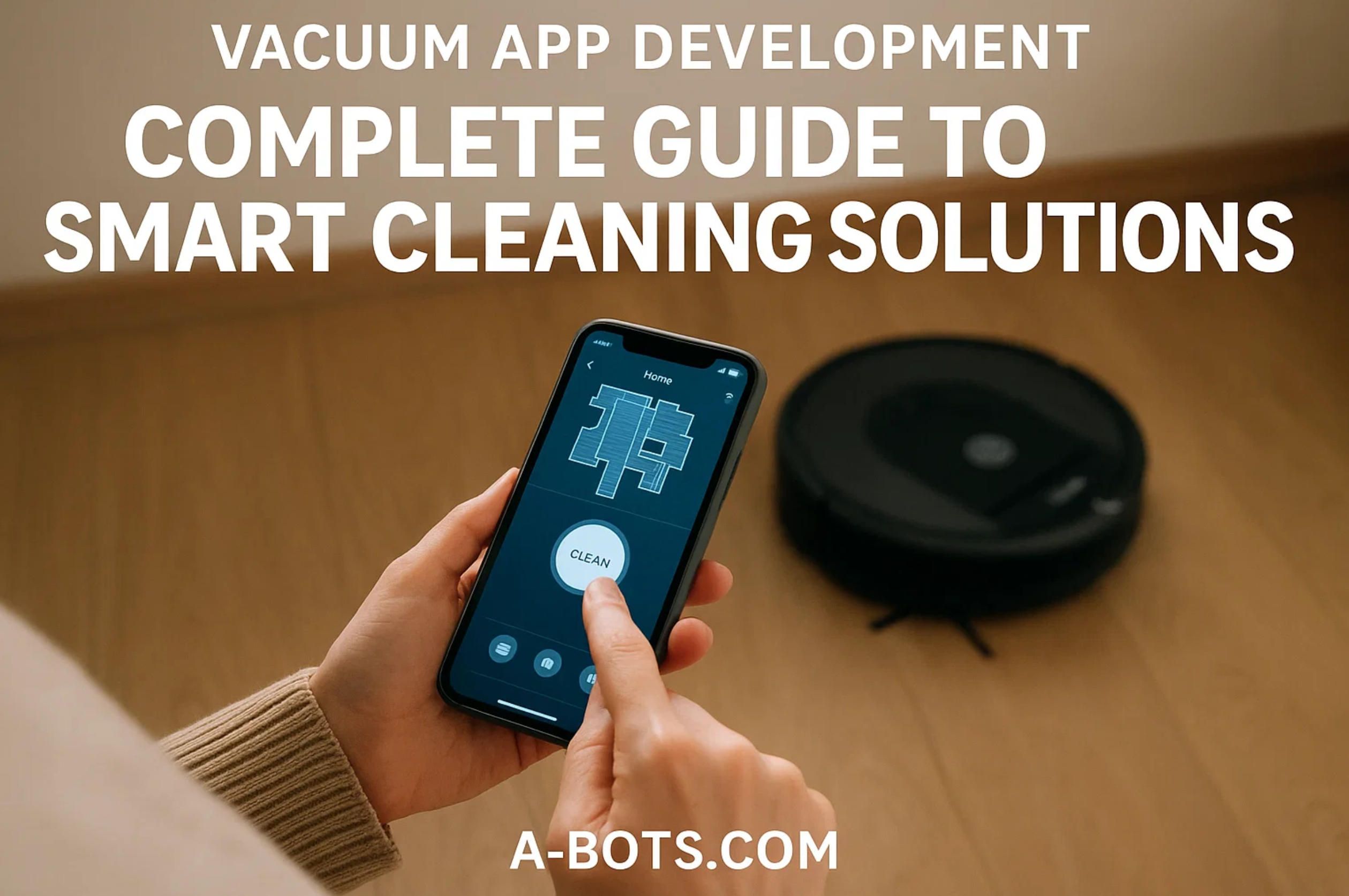
The revolution in home cleaning technology centers not on hardware specifications but on the vacuum app that transforms ordinary cleaning devices into intelligent home assistants. Whether developing a vac app for robotic wet vacuum cleaners or creating vacuum software development solutions for handheld cordless models, the mobile application defines the user experience and determines long-term product success in today's competitive market. More IoT Solutions.
The global wet vacuum cleaner market reached USD 2.42 billion in 2023 and projects to USD 3.76 billion by 2030 with a CAGR of 6.48 percent. Meanwhile, the broader vacuum cleaner market demonstrates even more dramatic expansion, growing from USD 44.24 billion in 2023 toward USD 74.98 billion by 2030. This explosive growth reflects not merely hardware improvements but the transformation of cleaning devices into connected ecosystem components where vacuum app development drives competitive differentiation.
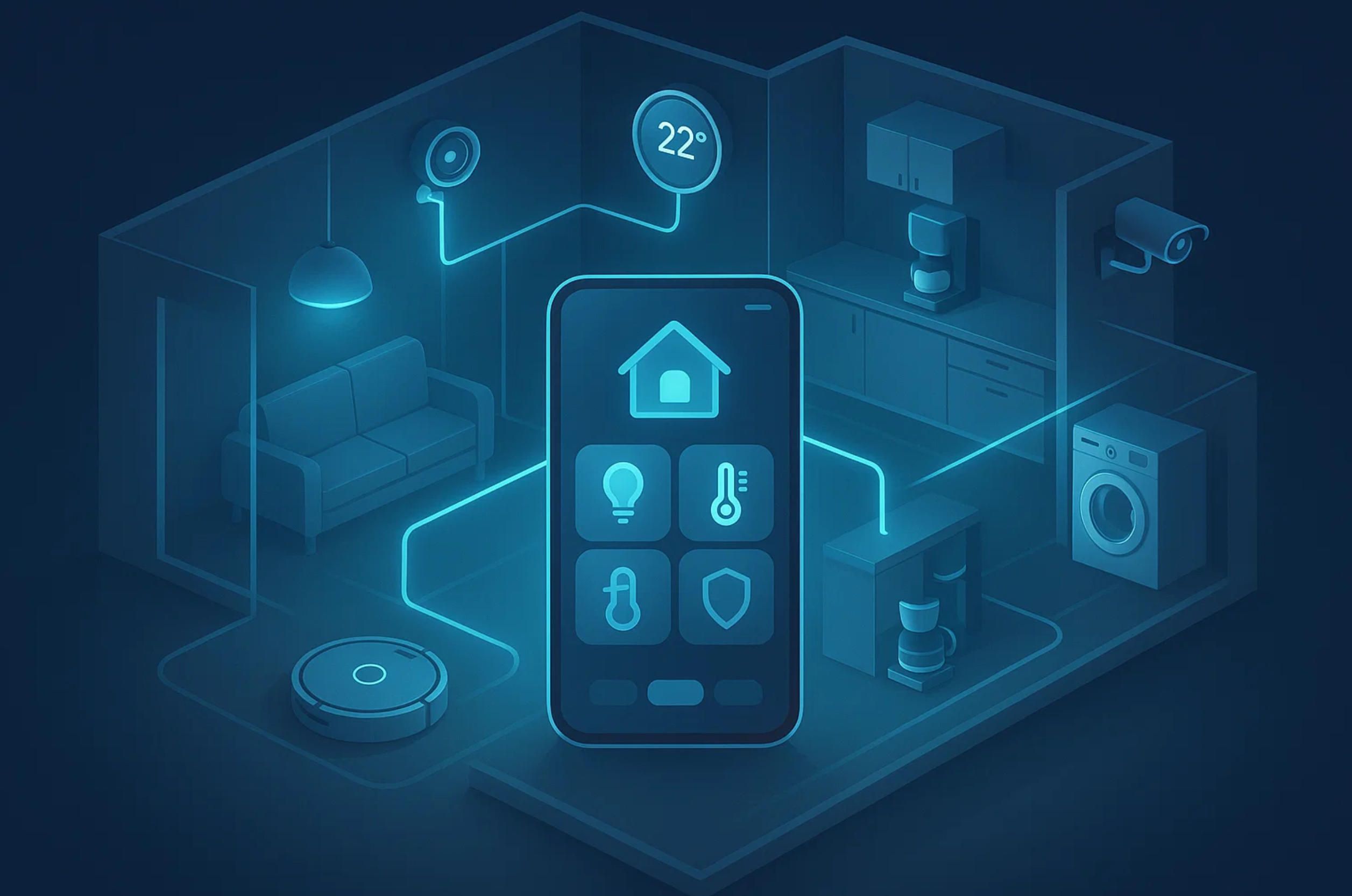
1. The Ecosystem Revolution: Smart Home Integration Through Vacuum Software Development
Modern homes increasingly embrace unified smart home ecosystems where every device communicates within a single information management system. The wet vacuum cleaner, whether robotic or handheld, deserves its place in this connected environment. Leading vacuum software development recognizes that cleaning appliances must integrate seamlessly with lights, coffee machines, electric kettles, stoves, leak detection sensors, water consumption monitors, washing machines, dryers, boilers, security systems, and surveillance cameras. This ecosystem approach transforms isolated appliances into coordinated intelligent assistants that enhance daily life.
Consider the practical implications. A comprehensive smart home ecosystem enables your vacuum app to coordinate with other devices in sophisticated ways. When motion sensors detect you leaving for work, the system can automatically trigger your robotic vacuum to begin cleaning. Water leak sensors can pause vacuuming in affected areas while alerting you through the same unified interface. Security cameras integrate with your vac app to provide visual confirmation that cleaning completed successfully. Your coffee machine can delay brewing until after the kitchen floor finishes mopping. The thermostat adjusts to compensate for the slight temperature increase from extended vacuum operation. These scenarios demonstrate why vacuum app development must consider broader ecosystem integration from the earliest design stages.
The trend toward universal connectivity means even manual handheld wet vacuum cleaners benefit enormously from dedicated mobile applications. A vacuum app for non-robotic models provides informative functions including filter replacement reminders based on actual usage patterns rather than arbitrary timeframes, detailed troubleshooting guidance that identifies specific malfunctions, interactive repair instructions utilizing augmented reality overlays, maintenance history tracking that optimizes performance over time, cleaning effectiveness monitoring through sensor data, and warranty management with automated service scheduling. When equipped with basic sensors and Bluetooth connectivity, even traditional vacuum cleaners can report cleaning routes, allowing homeowners to verify that cleaning staff or family members actually completed thorough housework. The vacuum app displays exactly which areas received attention and timestamps the cleaning session, creating accountability and quality assurance for domestic maintenance.
This democratization of smart features through vacuum software development means price points can remain accessible while delivering premium functionality. The vacuum app becomes the differentiator, not exotic hardware components. Manufacturers can offer basic models with limited physical sensors but extensive software capabilities, then upsell premium features through subscription tiers within the vac app. This software-first approach to vacuum app development creates recurring revenue streams while delivering continuous value to consumers through regular feature updates and improvements.
2. Essential Components of Professional Vacuum App Development
Successful vacuum app development requires architectural decisions that balance immediate functionality with long-term flexibility. The foundation begins with cross-platform compatibility, ensuring your vac app delivers consistent experiences on iOS, Android, tablets, and wearable devices. Users expect to control their vacuum from whatever device they happen to be holding, making universal access non-negotiable in modern vacuum software development.
Real-time synchronization represents another critical component. When a user creates a no-go zone in the vacuum app on their phone while sitting in the living room, that boundary must appear instantly in the web dashboard, sync to any tablets running the vac app, and remain accessible through voice assistant integrations like Alexa or Google Assistant. Achieving this seamless synchronization demands robust cloud infrastructure with delta-sync logic that resolves conflicts between offline device states and the latest server policies. Professional vacuum software development implements single-source-of-truth architectures where every device queries the same authoritative data store, eliminating the frustrating inconsistencies that plague inferior vac app implementations.
The user interface requires particular attention in vacuum app development. Cleaning device applications walk a fine line between offering powerful customization and overwhelming users with complexity. The most successful vacuum app implementations present a simple primary interface for everyday operations while exposing advanced features through progressive disclosure. A homeowner should be able to start a cleaning session with a single tap, but power users who want to optimize suction patterns for their specific carpet pile density can access those granular controls through clearly marked expert modes. This tiered approach to vacuum software development ensures broad appeal across diverse user sophistication levels.
Data visualization transforms raw sensor readings into actionable insights. Rather than confronting users with numerical suction measurements, the vacuum app should present intuitive graphics showing cleaning coverage, identify areas that require additional attention, display battery efficiency trends over time, and celebrate milestones like total square footage cleaned or hours of manual labor saved. This shift from data logging to narrative storytelling represents a fundamental advancement in vacuum app development philosophy. Users don't want spreadsheets; they want to understand how their vacuum is improving their home environment. The vac app bears responsibility for making that translation.
Security and privacy considerations pervade every aspect of vacuum software development. Vacuum cleaners equipped with cameras for navigation create potential surveillance concerns that demand thoughtful handling. The vacuum app must implement end-to-end encryption for video streams, provide transparent controls over what data gets stored and where, enable easy deletion of footage, and clearly communicate to users exactly what information the device collects and how it gets used. Vacuum app development teams must stay current with evolving privacy regulations across different markets, implementing GDPR compliance for European users, CCPA requirements for California residents, and similar frameworks emerging worldwide.
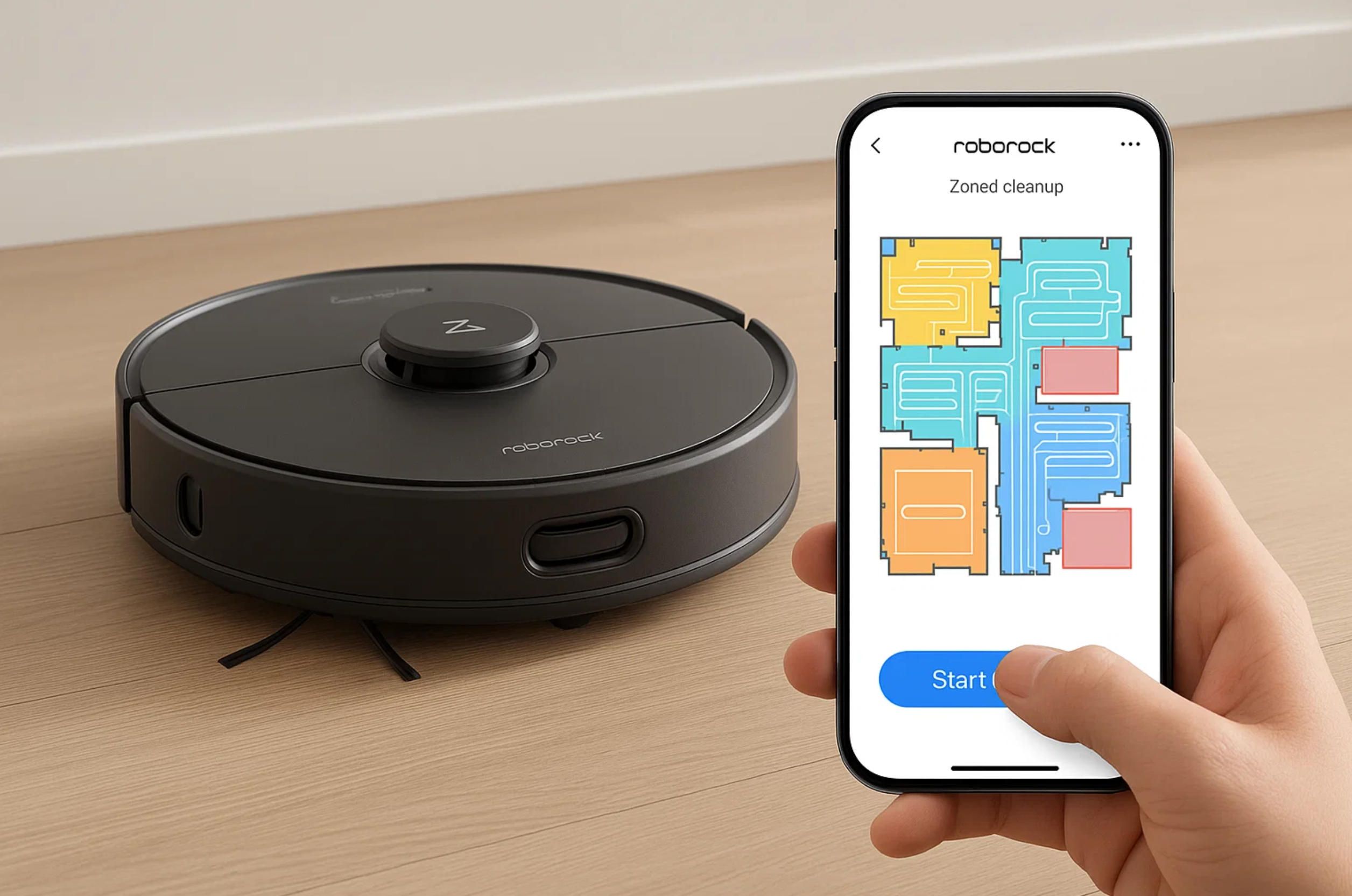
3. The Roborock App: Setting Industry Standards for Vacuum Software Development
The Roborock app represents perhaps the most refined example of vacuum app development currently available, consistently earning recognition as reviewers' favorite robot vacuum application. This preference stems from thoughtful design decisions that balance comprehensive functionality with intuitive operation. Examining the Roborock app provides valuable insights for any organization undertaking vacuum software development projects.
The Roborock app implements laser-based PreciSense LiDAR navigation that creates detailed maps of home environments with remarkable accuracy. This mapping technology forms the foundation for virtually every advanced feature in the vac app. After a single initial cleaning run, the Roborock app presents a complete floor plan, automatically segments rooms based on architectural features, and enables users to assign custom names to each space. This automated room division eliminates tedious manual map editing that plagues competing vacuum app implementations. Users can simply confirm or adjust the suggested room boundaries rather than drawing them from scratch.
The scheduling capabilities within the Roborock app demonstrate sophisticated understanding of real-world cleaning needs. Rather than limiting users to simple daily or weekly cleaning cycles, the vacuum software development team created a routine system that enables complex automation. Homeowners can specify that the kitchen requires cleaning after dinner every evening with high suction and mopping enabled, the bedrooms need vacuuming three times weekly in quiet mode during afternoon hours when no one is home, and the living room should receive attention every Sunday morning. Each room can have completely different suction levels, mopping intensities, and cleaning patterns. The Roborock app stores these routines for one-tap activation, learning from usage patterns to suggest optimizations.
Advanced features in the Roborock app include the distinctive Pet Snaps functionality found in camera-equipped models. During cleaning sessions, the vacuum identifies pets through AI-powered computer vision and captures photographs, which appear as icons on the cleaning map within the vac app. Pet owners appreciate this feature not just for entertainment value but as confirmation that their animals are safe and not distressed by the robot's operation. From a vacuum app development perspective, Pet Snaps exemplifies how thoughtful feature design creates emotional connections between users and their cleaning devices. The Roborock app transforms a utilitarian appliance into something that feels like a helpful household companion.
The maintenance tracking within the Roborock app provides another example of user-centered vacuum software development. Rather than relying on users to remember when components need cleaning or replacement, the vac app monitors actual usage and displays percentage-based lifecycle indicators for filters, brushes, sensors, and mop heads. When a component approaches end of life, the Roborock app sends proactive notifications with direct links to purchase replacements through integrated shopping features. This seamless transition from maintenance alert to parts ordering represents the kind of end-to-end experience that distinguishes professional vacuum app development from basic remote control interfaces.
Voice control integration demonstrates how the Roborock app extends beyond the smartphone interface. The vacuum software development team implemented their proprietary voice assistant that responds to "Hello Rocky" wake words, supporting dozens of natural language commands. Users can say phrases like "Hello Rocky, start cleaning," "Hello Rocky, mop harder," or "Hello Rocky, return to the dock." This independent voice system supplements rather than replaces integration with Alexa and Google Assistant, giving users choice in how they interact with their device. The Roborock app even includes a handy reference card listing all supported voice commands, acknowledging that discoverability remains a challenge in voice interfaces.
However, the Roborock app is not without limitations that highlight ongoing challenges in vacuum app development. Multiple reviewers note that the application supports only a single saved map despite many homes spanning multiple floors. This restriction forces users with multi-level residences to remap each time they move the vacuum between floors, significantly degrading the user experience. The room labeling system within the Roborock app uses a predefined list without custom label options, creating frustration when home layouts don't match the provided categories. Some users report buggy behavior when attempting to divide rooms or create virtual boundaries, with the vac app rejecting correctly drawn divider lines without clear error messaging.
These limitations underscore an important lesson for vacuum software development teams: even industry-leading applications have room for improvement. The Roborock app succeeds because its strengths far outweigh its weaknesses, but organizations undertaking vacuum app development should study both the successes and shortcomings to inform their own design decisions. User interface polish matters enormously in consumer applications, and vacuum software development must allocate sufficient resources to iterative refinement and usability testing.
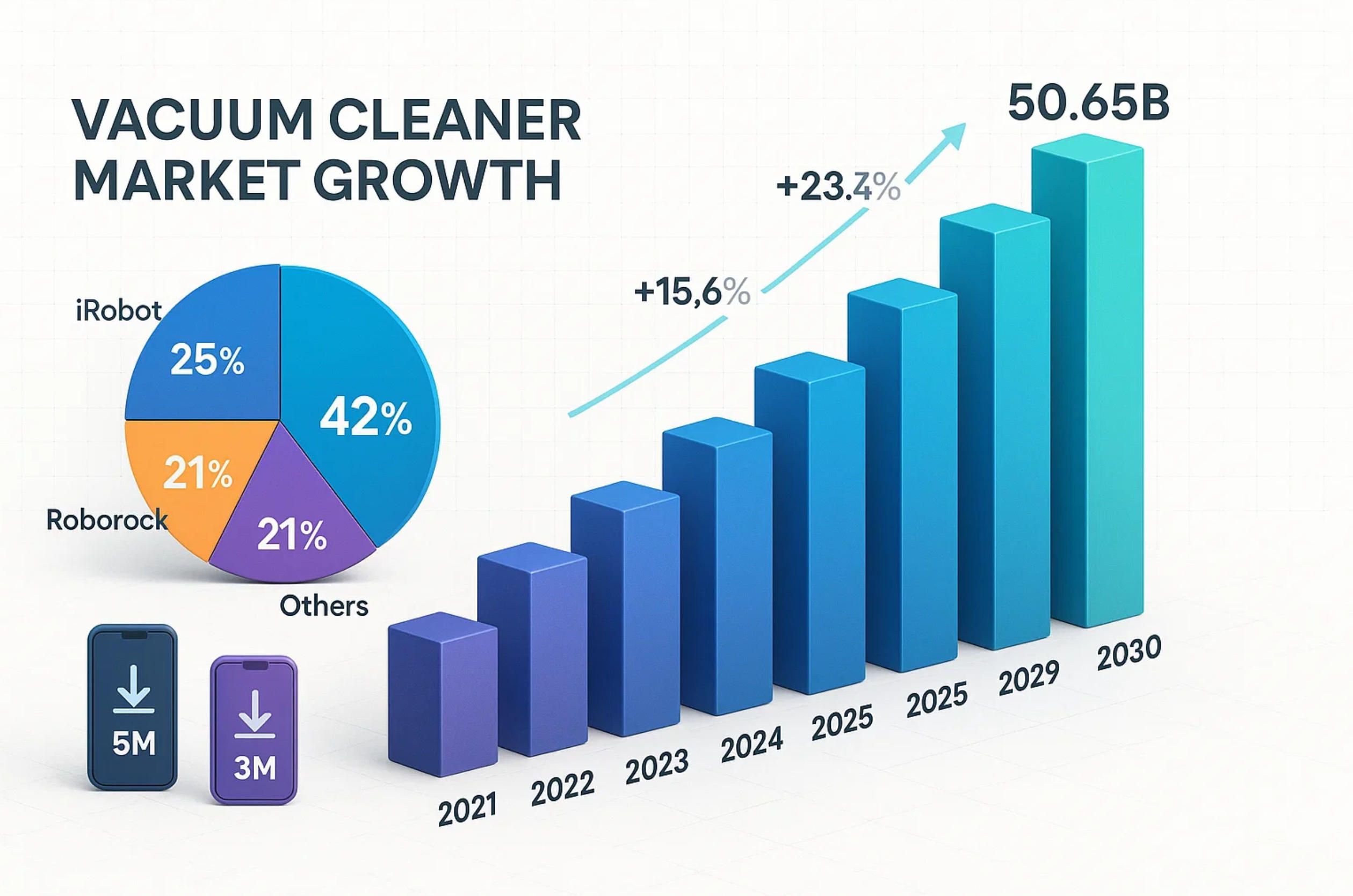
4. The iRobot App and Roomba App: Evolution of Vacuum App Development at Industry Pioneer
iRobot's vacuum app development journey reflects the company's position as the industry pioneer that introduced the first Roomba robot vacuum in 2002. Over more than two decades, iRobot has shipped over 50 million robots worldwide, accumulating massive amounts of user behavior data that informs their vacuum software development strategy. The company now maintains two distinct applications: the legacy iRobot Home (Classic) app supporting older Roomba models and the newer Roomba Home app designed for devices sold after March 2025. This dual-app approach creates short-term complexity but enables iRobot to implement modern architectural patterns without abandoning existing customers.
The Roomba Home app introduces Dirt Detective technology that represents a significant advancement in intelligent vacuum app development. Rather than relying on users to manually prioritize which rooms need attention, Dirt Detective analyzes historical cleaning data to understand the cleanliness state of each room. The vac app tracks how often each space gets cleaned and how frequently dirt events occur in different areas. Using this data, Dirt Detective automatically prioritizes the dirtiest rooms during cleaning sessions and applies optimal cleaning settings for each space. The Roomba app visualizes this cleanliness data through an intuitive home map that color-codes rooms by their current dirt state.
This predictive intelligence shifts vacuum software development from reactive control to proactive assistance. Users don't need to remember that the kitchen typically gets dirtier than the bedroom or that the hallway needs extra attention during muddy seasons. The Roomba app understands these patterns through continuous learning and adjusts behavior accordingly. When users initiate cleaning with Dirt Detective enabled, the vacuum app automatically creates an optimized cleaning plan that addresses the highest-priority areas first, ensuring that even if the battery runs low, the dirtiest spaces receive attention.
The Roomba Home app introduced dramatically faster initial mapping that creates complete floor plans after just one cleaning run, seven times faster than previous vacuum app implementations. This rapid mapping enables users to access advanced features immediately rather than waiting through multiple cleaning cycles before they can define rooms or set virtual boundaries. The vacuum software development team achieved this improvement through enhanced sensor fusion algorithms that construct accurate spatial models from less data, demonstrating how software optimization can deliver tangible user experience benefits without hardware changes.
The iRobot Home app features robust routine building capabilities that rival or exceed competing vacuum app implementations. Users can create custom cleaning routines that specify which rooms to clean, adjust suction and mopping settings room-by-room, enable advanced scrubbing for stubborn stains, and schedule these routines to run automatically at specified times. The Roomba app saves favorite routines for one-tap access, making it effortless to run that "quick pre-guests-arriving living room and kitchen clean" versus the "thorough weekend whole-house deep clean." This flexibility in vacuum software development acknowledges that cleaning needs vary dramatically depending on context and circumstances.
The maintenance and health dashboard within the Roomba app provides comprehensive monitoring of robot and accessory status. The vac app offers proactive maintenance suggestions, troubleshooting guidance with illustrated instructions, lifecycle tracking for consumable components, and performance monitoring to identify degradation that might indicate problems. When issues occur, the Roomba app displays clear diagnostic information that helps users resolve problems without contacting customer support. For cases that do require professional assistance, the vacuum software development team implemented in-app pathways to reach support with relevant diagnostic data automatically attached to service requests.
Voice control integration in the iRobot app supports Alexa, Siri, and Google Assistant through robust API implementations. Users can create custom shortcuts that map complex cleaning routines to simple voice commands. The Roomba app enables these automations through its Settings interface, allowing users to define that "Hey Siri, morning routine" should trigger vacuum and mop in the kitchen and breakfast nook, or "Alexa, clean up after the kids" starts targeted cleaning in playroom areas. This level of customization in vacuum app development acknowledges that voice control becomes truly useful only when users can define interactions that match their specific household vocabulary and needs.
Despite these strengths, the Roomba app faces criticism in user reviews that highlights persistent challenges in vacuum software development. Multiple users report that the application makes it unnecessarily difficult to perform basic "start cleaning now" operations, forcing users through the automation or routine menus rather than providing a prominent quick-start button. Some reviewers complain about slow loading times and indefinite loading symbols when trying to view cleaning progress, which the vacuum app specifically advertises as a key feature. Others note font size issues that make certain interface elements difficult or impossible to read, particularly when trying to schedule cleanings for specific days of the week on devices with smaller screens.
These usability problems underscore the importance of continuous refinement in vacuum software development. Even established companies with massive resources and decades of experience struggle to deliver consistently excellent vac app experiences. The pace of operating system updates, the diversity of device screen sizes, and the evolution of user expectations create moving targets that demand ongoing investment. Organizations planning vacuum app development projects should budget for sustained post-launch maintenance and improvement rather than treating the application as a one-time deliverable.
The iRobot vacuum app development team has also faced criticism for map editing functionality that users find less intuitive than competing applications. The process of dividing the automatically generated floor plan into properly labeled rooms sometimes produces frustrating results, with the Roomba app incorrectly identifying room types and resisting user corrections. Some reviewers note that they achieved better results with Dyson or competing vacuum software development implementations when it comes to these crucial mapping functions. This feedback highlights how even market leaders can fall behind in specific feature areas, creating opportunities for new entrants who excel in vacuum app development to capture market share through superior user experience.
5. The ECOVACS App: Global Vacuum Software Development for Mass Market
The ECOVACS HOME app represents vacuum software development optimized for global markets where price sensitivity demands careful feature prioritization. ECOVACS has built a reputation for delivering solid robotic cleaning solutions at accessible price points, and their vacuum app reflects this philosophy through a focus on essential functionality with selective premium features in higher-tier models. The vac app supports the company's DEEBOT line of robot vacuum cleaners, which has earned strong market presence particularly in Asia-Pacific regions where ECOVACS holds significant competitive advantages.
The ECOVACS app implements basic remote control functions that every vacuum software development project must address: start, pause, and stop cleaning sessions; schedule regular automated cleaning; adjust suction power levels; configure voice reporting preferences; set do-not-disturb periods when the vacuum should remain quiet; and receive notifications from WiFi-enabled robots. These fundamentals form the table stakes for any credible vac app, and ECOVACS delivers them through a straightforward interface that prioritizes accessibility over visual flair. The vacuum app presents cleaning controls prominently on the home screen with clear labels and generous touch targets suitable for users with varying levels of technical sophistication.
Models equipped with Smart Navi mapping technology unlock advanced features within the ECOVACS app that approach the capabilities found in premium vacuum software development implementations. Users can create Virtual Boundaries that establish no-go zones where the vacuum should never enter, useful for protecting areas with delicate items or restricting access to spaces with cable clutter. The Custom Cleaning feature enables homeowners to designate specific zones for targeted cleaning, perfect for addressing spills or high-traffic areas without running a full-house session. The ECOVACS app displays real-time statistics during cleaning including a visual map showing coverage, total area cleaned, and elapsed time, giving users tangible feedback about the vacuum's activity.
The water flow level adjustment for mopping-capable robots demonstrates thoughtful vacuum app development that addresses practical cleaning needs. Different floor surfaces and soil levels require varying moisture amounts for optimal results, and the ECOVACS app enables users to tune water flow from minimal dampening to more aggressive mopping. This granular control prevents over-wetting sensitive wood floors while ensuring tile or vinyl surfaces receive sufficient moisture to lift sticky residues. The vac app remembers these preferences on a room-by-room basis when combined with mapping features, automatically adjusting water flow as the robot transitions between spaces.
The multi-user account sharing feature within the ECOVACS app acknowledges the reality that household cleaning is often a shared responsibility. Family members or roommates can all install the vac app on their individual devices and access the same vacuum, enabling anyone to start cleaning, adjust schedules, or check status. The vacuum software development team implemented appropriate permission controls to prevent conflicts, such as preventing simultaneous control attempts that might send contradictory commands. This multi-device approach extends to the web dashboard that ECOVACS provides for users who prefer larger screens when configuring complex schedules or editing maps.
Firmware and software updates deliver through the ECOVACS app automatically or on-demand depending on user preferences. The vacuum software development team uses these updates to continuously improve performance, add new features, and address any bugs discovered after launch. The vac app handles the entire update process seamlessly, downloading new firmware in the background and prompting users to install when convenient. This ongoing improvement cycle means ECOVACS customers receive enhanced value over the product lifecycle rather than being frozen at the feature set available at purchase.
The ECOVACS app includes comprehensive support resources directly within the interface, reducing friction when users need assistance. The vacuum app provides access to instruction manuals specific to the user's model, video tutorials demonstrating key features and maintenance procedures, frequently asked questions addressing common issues, and direct contact pathways to customer service. This integrated help system reflects smart vacuum software development that recognizes users will inevitably encounter questions and should be able to find answers without leaving the application or hunting through external websites.
Premium DEEBOT models introduce camera-based features that significantly expand the ECOVACS app's functionality beyond cleaning control. The video streaming capability enables users to remotely monitor their home while away, viewing live footage from the robot's onboard camera. The vac app includes two-way audio communication, allowing homeowners to speak to pets or family members through the vacuum's speaker while watching through the camera. This security monitoring function transforms the cleaning device into a multi-purpose home assistant, demonstrating how creative vacuum software development can extract additional value from existing hardware components.
Voice assistant integration allows ECOVACS app users to control their robots through Alexa and Google Home with simple natural language commands. The vacuum app establishes the necessary API connections during initial setup, and thereafter users can say phrases like "Alexa, tell DEEBOT to start cleaning" or "OK Google, send the robot home." This voice control supplements the mobile interface for hands-free operation, particularly convenient when users are occupied with other tasks. The vacuum software development team documented extensive command libraries that users can explore within the ECOVACS app settings.
However, the ECOVACS app receives mixed feedback in user reviews that reveals persistent challenges in vacuum app development. Many users praise the basic functionality as solid and reliable for everyday cleaning needs, but criticize more advanced features, particularly mapping and room division, as buggy and frustrating. Several reviewers report difficulty getting the vac app to properly segment their floor plans into correctly labeled rooms, with the application inexplicably merging spaces that should remain separate or refusing to recognize manual divisions. The inconsistent behavior creates substantial user frustration given that proper mapping underpins most advanced features.
The user interface design within the ECOVACS app draws criticism for lacking adequate contextual help and tutorials. New users report feeling confused by various icons and options without clear explanation of what each feature does or how to use it effectively. The vacuum software development team could significantly improve user experience by implementing better onboarding flows with interactive walkthroughs of key features. Some reviewers express frustration that basic operations that should be straightforward require hunting through multiple menu levels, suggesting that information architecture needs refinement to better match user mental models.
Performance issues also appear in ECOVACS app reviews, with users reporting slow response times, failed loading of cleaning routines, and occasional complete inability to connect with their robots. While these problems appear intermittent rather than universal, they significantly degrade user experience when they occur. The vacuum app may work perfectly for days or weeks, then suddenly fail to load critical screens or sync with the device, forcing users to restart the application or troubleshoot connectivity. This unreliability undermines confidence in the vacuum software development and creates negative associations with the brand despite generally solid hardware performance.
The cleaning log management represents another pain point highlighted in user feedback. The ECOVACS app stores detailed records of every cleaning session, which provides valuable historical data but accumulates quickly in the interface. Reviewers request bulk deletion options to clear months of logs in a single action, rather than requiring individual selection and deletion of each entry. This seemingly small detail substantially impacts user experience for long-term owners whose vac app becomes cluttered with extensive cleaning history. Thoughtful vacuum software development would provide efficient data management tools that let users maintain clean interfaces without losing access to genuinely useful historical analytics.
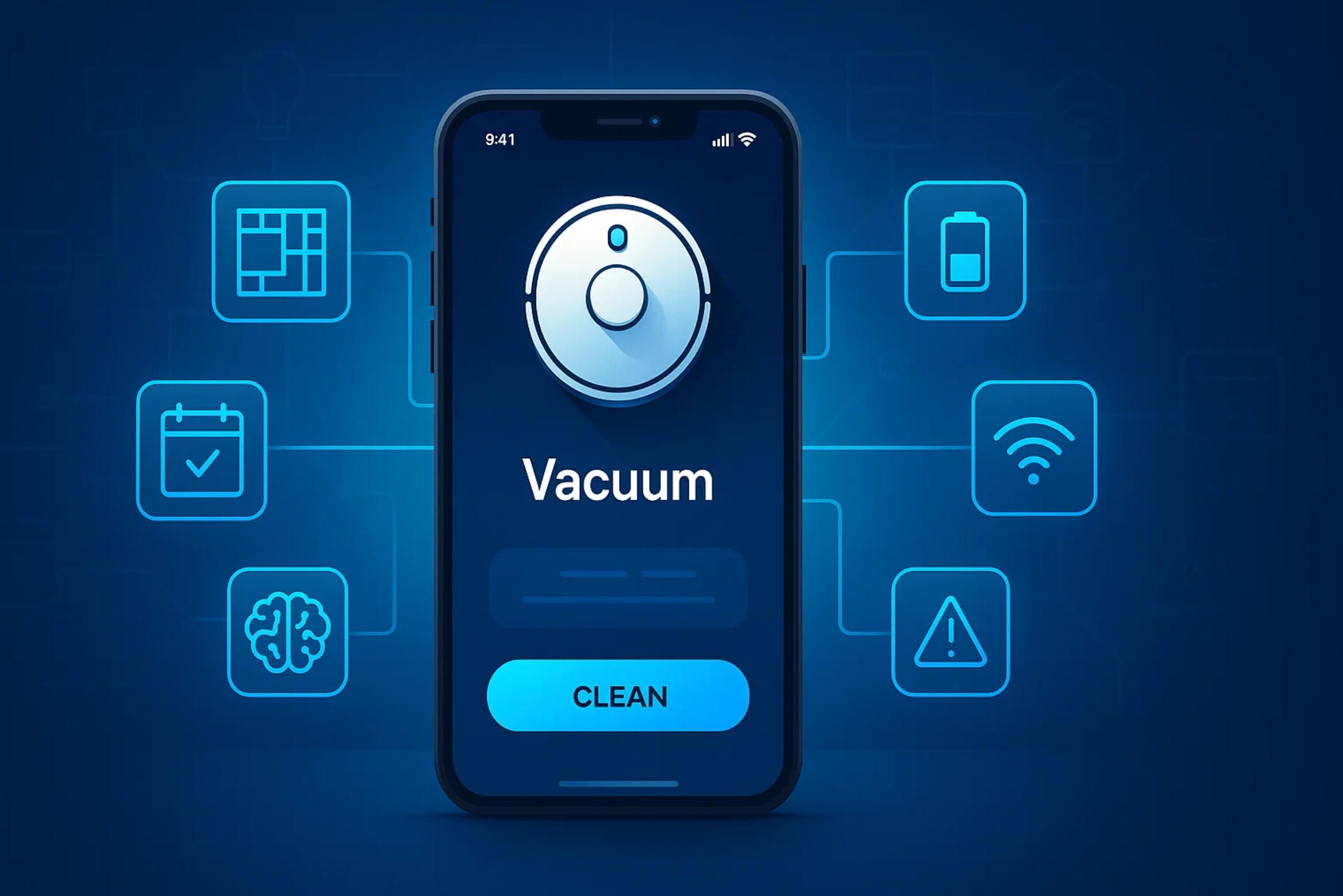
6. Comprehensive Vacuum App Development Services from A-Bots.com
A-Bots.com delivers end-to-end vacuum app development services that transform cleaning device concepts into market-ready connected solutions. Our expertise spans the entire vacuum software development lifecycle, from initial discovery and requirements analysis through post-launch support and continuous improvement. Whether you need a complete vac app created from scratch or want to enhance existing vacuum software development with additional features, our team brings the technical excellence and market insight that drive success.
Our vacuum app development process begins with comprehensive discovery where we assess your current product capabilities, identify competitive differentiation opportunities, analyze the market landscape, and define measurable success criteria. This foundation ensures that the vacuum software development effort aligns with business objectives rather than simply implementing features that sound technically impressive. We work closely with your team to understand user personas, use cases, pain points, and aspirations that should guide design decisions throughout the vac app creation.
The design phase translates requirements into tangible user experiences through detailed wireframes, interactive prototypes, and comprehensive user journey mapping. Our vacuum software development team conducts usability testing with representative users from your target demographic, gathering feedback that informs iterative refinement before writing production code. This investment in upfront design dramatically reduces expensive rework during development and ensures the finished vac app delivers intuitive experiences that users love. We create detailed design specifications that document every screen, interaction, and edge case, providing clear guidance for developers and reducing ambiguity that leads to implementation delays.
Development proceeds through agile sprints with continuous integration enabling early testing and validation. Our vacuum app development team utilizes modern frameworks and best practices for iOS and Android platforms, ensuring consistent behavior across devices while respecting platform-specific conventions that users expect. The technical architecture incorporates cloud services for data synchronization, authentication, storage, and analytics, implemented through scalable infrastructure that grows with your user base. We build comprehensive API layers that facilitate integration with voice assistants, smart home platforms, and third-party services, recognizing that vacuum software development must support ecosystem participation rather than operating in isolation.
Quality assurance runs parallel to development through automated test suites that validate functionality, performance, security, and compatibility across device matrices. Our vacuum app development process includes rigorous manual testing to identify usability issues that automated systems miss, compatibility verification across major phone and tablet manufacturers, performance optimization to ensure responsive interfaces even on older devices, and security audits to protect user data and prevent vulnerabilities. We test the vac app under various network conditions including poor connectivity and complete offline operation, ensuring graceful degradation rather than catastrophic failures when communication problems occur.
The deployment phase manages app store submissions, implements phased rollout strategies to detect issues before full release, monitors adoption metrics and user feedback, and provides rapid response to any emerging problems. Our vacuum software development team navigates the submission requirements and review processes for Apple's App Store and Google Play, addressing any compliance issues that arise during approval. We implement feature flags and remote configuration that enable adjusting vac app behavior without requiring new releases, providing flexibility to test features with subset of users or quickly disable problematic functionality if issues emerge.
Post-launch support includes regular feature enhancements informed by user feedback and market evolution, performance optimization as usage patterns reveal bottlenecks, integration of new hardware capabilities as they become available, proactive security updates addressing emerging threats, and comprehensive analytics implementation to understand how users actually interact with the vacuum app. Our vacuum software development philosophy emphasizes continuous improvement rather than treating launch as the end of the project. We establish feedback loops with your customer support team, monitor app store reviews and social media mentions, and track detailed usage analytics to identify opportunities for enhancement.
For clients with existing vacuum app implementations, A-Bots.com provides comprehensive testing and quality assurance services that identify issues, validate functionality, and ensure excellent user experiences. Our vacuum software development testing methodology addresses device compatibility across hundreds of phone and tablet models, network connectivity under realistic conditions including congestion and interference, navigation and mapping accuracy in diverse home layouts, cleaning performance verification for suction and mopping functions, integration testing with voice assistants and smart home platforms, security assessment including penetration testing and vulnerability scanning, usability evaluation through representative user testing, and long-term reliability validation simulating months of operation. These rigorous testing protocols catch problems before they reach end users, protecting brand reputation and customer satisfaction.
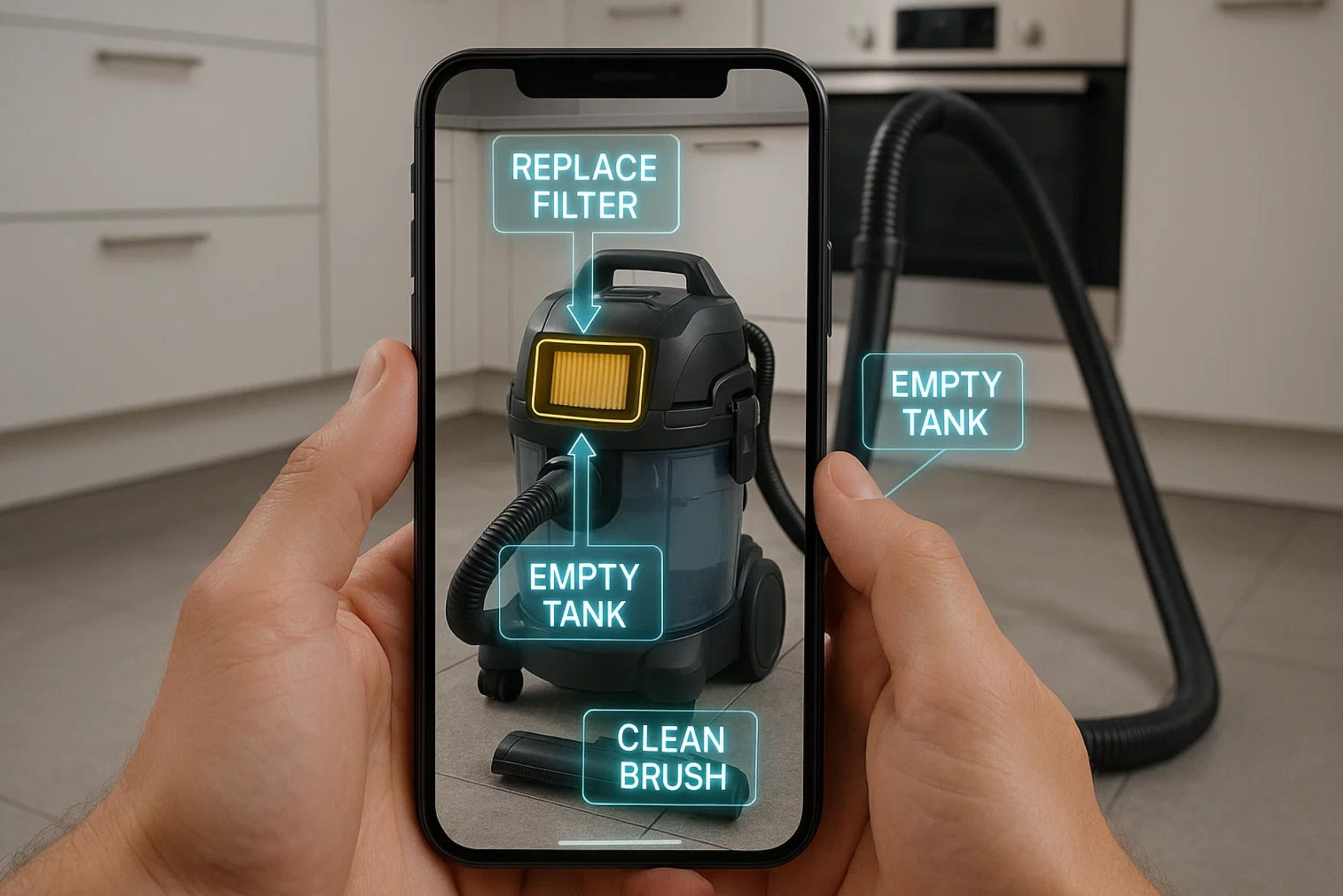
7. Augmented Reality and Advanced Service Features in Vacuum App Development
The integration of augmented reality represents the frontier of vacuum software development, transforming how users interact with and maintain their cleaning devices. Forward-thinking vac app implementations leverage smartphone cameras to overlay digital information on physical environments, creating intuitive interfaces that bridge the gap between virtual controls and real-world cleaning tasks. For handheld wet vacuum cleaners, AR features within the vacuum app can display proper attachment installation procedures, guide users through maintenance routines with step-by-step visual overlays, highlight areas that require cleaning attention, and visualize cleaning paths to ensure complete coverage.
When a vacuum app detects that the user is experiencing reduced suction, for example, AR capabilities can guide troubleshooting by overlaying arrows and instructions on the live camera view showing exactly which components to check and how to clean or replace them. Rather than struggling to interpret two-dimensional diagrams in a printed manual, the user simply points their phone at the vacuum and follows highlighted visual cues. This application of augmented reality in vacuum software development dramatically reduces the technical knowledge required for proper maintenance, empowering non-technical users to perform procedures that might otherwise require service calls.
The same AR principles apply to initial setup and assembly. A vacuum app equipped with augmented reality can recognize vacuum components through computer vision, confirm that the user has all necessary parts, and provide animated overlays showing exactly how pieces fit together. For wet vacuum cleaners with multiple tank configurations, the vac app can verify correct installation by checking that components match the expected spatial relationships. This intelligent assistance through vacuum software development reduces setup frustration and prevents damage from incorrect assembly.
Beyond maintenance assistance, augmented reality enables vacuum app features that enhance actual cleaning effectiveness. For robotic vacuums, the vac app can leverage the phone's camera to show the robot's planned cleaning path overlaid on the real floor, allowing users to quickly verify coverage and adjust virtual boundaries if needed. For handheld models, AR features in the vacuum software development can analyze the floor surface and suggest optimal cleaning techniques, display which areas have already been cleaned to prevent redundant work, and estimate remaining cleaning time based on the area that still requires attention.
The serviceable diagnostic capabilities possible through advanced vacuum app development transform how manufacturers support their products in the field. When a vacuum experiences problems, the vac app can run comprehensive diagnostics and present the results in user-friendly language that identifies the specific issue. For minor problems, the vacuum app provides step-by-step resolution guidance. For more serious issues, the vacuum software development can automatically generate detailed diagnostic reports that accompany service requests, enabling technicians to arrive prepared with correct replacement parts and relevant expertise. This streamlined service process reduces downtime and improves customer satisfaction by eliminating multiple service visits for diagnosis and repair.
Filter replacement scheduling represents a significant opportunity for value-added vacuum app features. Rather than arbitrary timeframes based on average usage, intelligent vacuum software development monitors actual airflow, suction performance, and run time to determine when filters genuinely need replacement. The vac app sends proactive notifications when performance degradation indicates a filter change would restore optimal operation, often before users consciously notice the decline. Integration with e-commerce platforms enables one-tap ordering of genuine replacement parts, creating seamless maintenance cycles that keep the vacuum performing optimally while generating recurring accessory revenue.
8. The Future of Vacuum Software Development: Predictive Intelligence and Ecosystem Integration
The evolution of vacuum app development points toward increasingly sophisticated predictive capabilities that anticipate user needs rather than simply responding to commands. Machine learning models analyze historical cleaning patterns, seasonal variation, household occupancy, and environmental factors to automatically optimize cleaning schedules without requiring explicit user input. The vac app learns that kitchen cleaning becomes more critical after weekend cooking sessions, bedrooms need less attention during vacation periods when no one occupies them, and entryways require extra focus during rainy seasons when muddy footprints increase. This intelligent adaptation represents the future of vacuum software development where devices become truly autonomous helpers rather than remote-controlled tools.
Integration depth with broader smart home ecosystems will continue expanding as vacuum app development embraces emerging standards like Matter that enable seamless interoperability. Future vac app implementations will coordinate more tightly with HVAC systems to optimize air quality during and after cleaning, adjust lighting to enhance navigation camera performance, pause entertainment systems to prevent audio interference, and synchronize with occupancy detection to avoid cleaning when people are present. The vacuum app becomes a first-class citizen in home automation alongside lighting, climate, security, and entertainment systems, participating in complex scenarios that orchestrate multiple devices toward common goals.
The service model for vacuum software development is shifting from one-time purchases toward subscription relationships that deliver continuous value. Future vac app implementations may offer premium tiers that unlock advanced features like unlimited map storage for multi-floor homes, extended cleaning history and analytics, priority customer support through in-app chat, exclusive access to beta features before general release, and deeper integration capabilities with third-party smart home platforms. This software-as-a-service approach aligns manufacturer incentives with long-term customer satisfaction while creating predictable revenue streams that fund ongoing vacuum app development and improvement.
Predictive maintenance represents one of the most valuable directions for vacuum software development evolution. By continuously monitoring performance metrics, the vac app can detect subtle degradation patterns that indicate impending component failures before they cause problems. The vacuum app might notice that brush motor current draw is gradually increasing, suggesting bearing wear that will eventually cause failure. Rather than waiting for the motor to burn out mid-cleaning, the vac app proactively schedules maintenance, orders replacement parts, and arranges service before the problem disrupts operation. This predictive capability transforms maintenance from reactive fire-fighting into planned optimization.
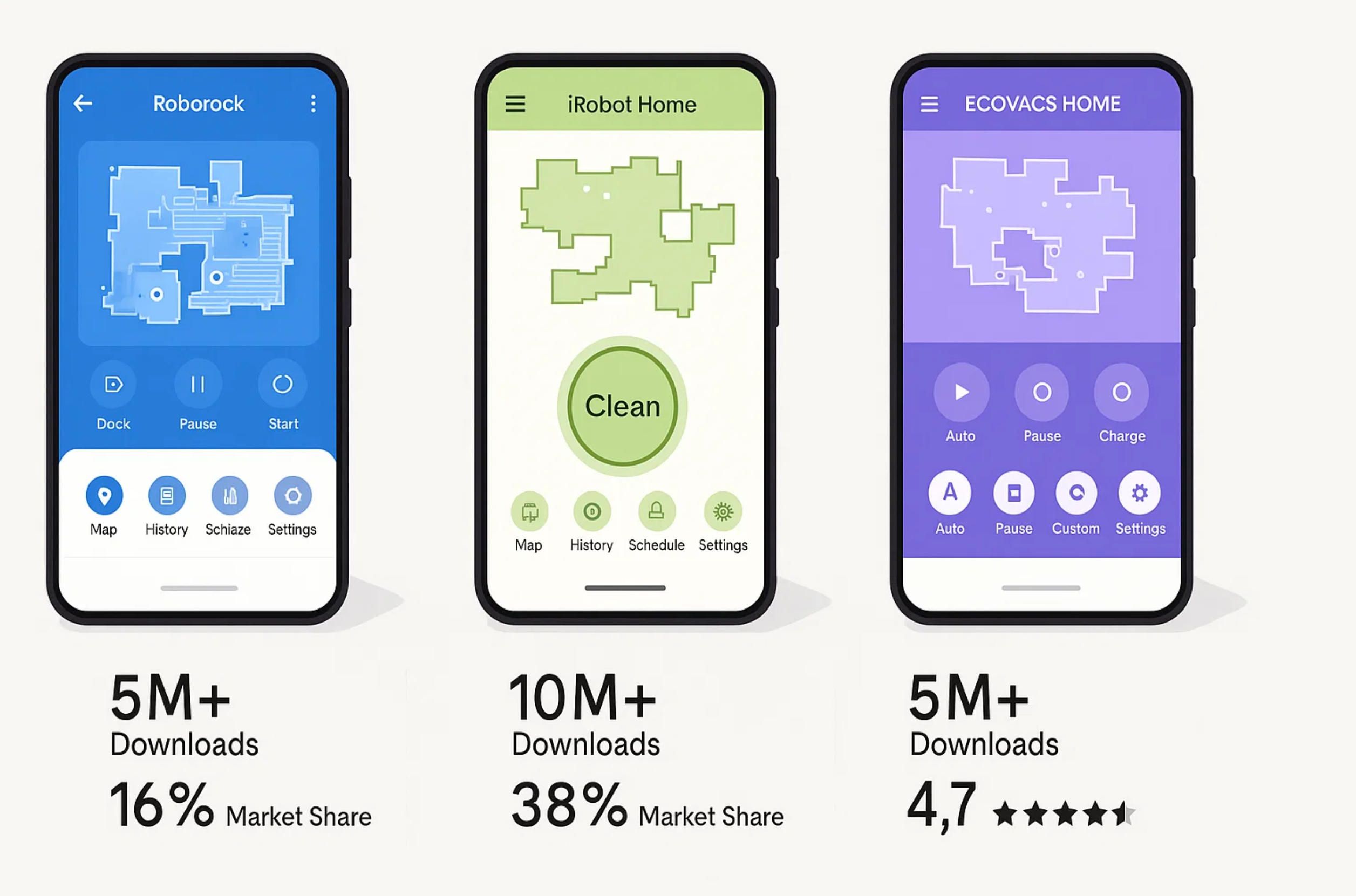
9. Market Dynamics: Statistical Evidence of Vacuum App Development Impact
Understanding the competitive landscape provides crucial context for vacuum app development decisions. The robotic vacuum cleaner market demonstrates explosive growth, expanding from USD 4.48 billion in 2021 toward a projected USD 50.65 billion by 2028 at a remarkable CAGR of 27.2 percent according to Fortune Business Insights. More recent analysis suggests the market reached USD 11.14 billion in 2025 and projects to USD 35.56 billion by 2035 with a CAGR of 12.3 percent, reflecting sustained consumer appetite for automated cleaning solutions where vacuum software development plays a central role in differentiation.
The concentration of market power among leading brands reveals the strategic importance of superior vac app implementations. iRobot, ECOVACS, and Roborock collectively hold approximately 50 percent of the global market, with their dominance stemming not merely from hardware quality but from comprehensive vacuum app ecosystems that create sticky user relationships. Asia-Pacific commands 45 to 50 percent of the global market share, driven by manufacturing prowess and rapid adoption in China, Japan, and South Korea where brands like ECOVACS and Roborock originated. North America represents 42 percent of the market with the United States alone generating USD 850 million in revenue during 2023, demonstrating strong consumer willingness to invest in premium vacuum software development experiences.
Market share evolution tells a fascinating story about vacuum app development importance. iRobot maintained dominant positioning from 2014 through 2020, holding 64 percent market share at its 2016 peak before declining to 46 percent by 2020 as competitors delivered compelling vacuum app alternatives. ECOVACS steadily gained ground from 7 percent market share in 2014 to 17 percent in 2020, while Roborock emerged as a formidable challenger growing from 4 percent in 2018 to 9 percent in 2020. SharkNinja demonstrated explosive growth in North America, expanding from approximately 10 percent market share in 2019 to 18 percent by 2020 and continuing aggressive expansion through 2025, largely on the strength of intuitive vac app experiences and competitive pricing.
Regional market dynamics vary dramatically with important implications for vacuum software development strategies. In China, ECOVACS commanded 40.13 percent market share during early 2022 with Roborock capturing 20.13 percent and NARWAL holding 15.79 percent, demonstrating local brand strength in the world's largest market. Xiaomi held 10.26 percent reflecting its broader consumer electronics ecosystem advantages. In India, consumer preferences showed Xiaomi leading with 44 percent preference share, followed by iRobot at 12 percent and Libra at 11 percent, indicating that affordable vacuum app experiences resonate strongly in price-sensitive emerging markets.
App download statistics provide indirect but valuable insight into active user bases and brand momentum. The iRobot Home Classic app accumulated over 13 million downloads on Android through 2025 with an average of 3,600 downloads daily, demonstrating the massive installed base that iRobot maintains despite increasing competitive pressure. The ECOVACS HOME app reached 4.2 million downloads averaging 3,200 daily downloads, showing strong traction particularly in Asia-Pacific markets. While exact download figures for the Roborock app prove elusive in public data, the company's 15 percent global market share in 2022 according to IFR data suggests comparable install bases. These download numbers translate directly into vacuum software development opportunities as each installation represents a user whose experience depends entirely on application quality.
Household penetration rates reveal substantial growth runway for vacuum app development innovation. Over 10 percent of households now own robotic vacuum cleaners with adoption expected to double within five years according to Future Market Insights research. In the United States, penetration reached 15 percent of households by 2023 per Consumer Technology Association data, up from negligible levels a decade earlier. This expanding user base creates opportunities for vacuum software development differentiation as more consumers experience competing vac app implementations and develop strong preferences based on usability, reliability, and feature richness.
The 2-in-1 vacuum-mop segment demonstrates the fastest growth at 12.3 percent CAGR according to Vacuum Wars analysis, with hybrid functionality creating additional vacuum app development complexity and opportunity. Approximately 66 percent of U.S. households own pets, driving demand for specialized features including tangle-resistant brushes, HEPA filtration, pet waste avoidance, and allergen tracking that must be surfaced through intuitive vac app interfaces. The cordless vacuum segment projected to reach USD 14.2 billion by 2034 indicates that even non-robotic devices benefit enormously from connected vacuum software development that enables smart features previously exclusive to robotic models.
Hardware shipment trajectories underscore market vitality. The International Federation of Robotics reported approximately 31 million consumer robot units sold globally in 2022 with robotic vacuum cleaners comprising the largest category. Shipment projections suggest 19.63 million units in 2024 growing to 22.1 million units in 2025, representing year-over-year expansion that creates millions of new vacuum app installations annually. Each device sold represents not just hardware revenue but an ongoing vacuum software development relationship where manufacturers can deliver value through feature updates, service integrations, and ecosystem expansions.
The competitive intensity reflected in these statistics highlights why superior vacuum app development constitutes strategic imperative rather than optional enhancement. When ECOVACS introduces OZMO ROLLER Instant Self-Washing technology or Roborock unveils mechanical arm-equipped models like the Saros Z70, the hardware innovations only reach consumers through vac app interfaces that make capabilities discoverable and controllable. Manufacturers who treat vacuum software development as afterthought rather than core competency risk ceding market share to competitors who recognize that user experience begins and ends with the application regardless of underlying hardware sophistication.
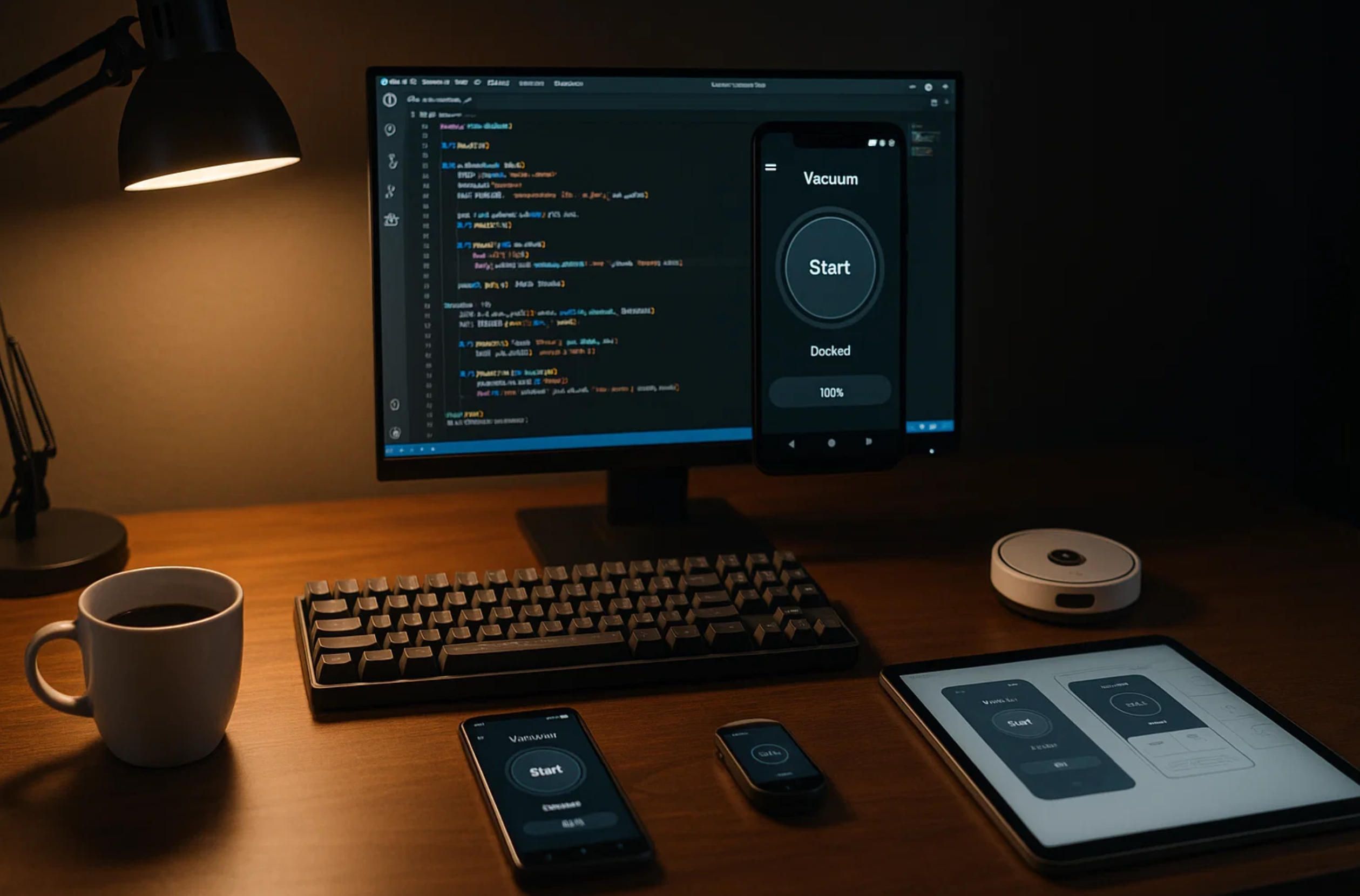
10. Partnering for Excellence in Vacuum Software Development
The transformation of cleaning devices from standalone appliances into connected intelligent assistants creates unprecedented opportunities for manufacturers willing to invest in exceptional vacuum app development. Success in today's market requires more than capable hardware; it demands vacuum software development that delights users, anticipates needs, and continuously improves through data-driven optimization. Whether you manufacture robotic wet vacuum cleaners for premium markets or handheld cordless models targeting value segments, the vac app determines competitive positioning and long-term customer satisfaction.
A-Bots.com brings specialized expertise in vacuum app development and comprehensive quality assurance capabilities tailored specifically for smart cleaning devices. Our team understands the unique requirements of vacuum software development including real-time navigation display, battery management optimization, obstacle avoidance interface, cleaning effectiveness measurement, maintenance scheduling, and ecosystem integration. We deliver the technical excellence, design sophistication, and market insight that transform cleaning device concepts into successful products that users love.
Whether you need complete custom vacuum app development from concept through deployment or comprehensive testing services for existing implementations, A-Bots.com provides the expertise that drives success in this rapidly growing sector. The future of home cleaning is intelligent, connected, and automated. Partner with A-Bots.com to transform your vacuum cleaner from a cleaning tool into a smart home essential that users love, powered by vacuum software development that sets new industry standards.
✅ Hashtags
#VacuumAppDevelopment #VacuumSoftwareDevelopment #VacApp #VacuumApp #RoborockApp #iRobotApp #RoombaApp #EcovacsApp #SmartHomeApps #IoTDevelopment #MobileAppDevelopment #RoboticVacuum #SmartCleaningTech #HomeAutomation #AIVacuum #ConnectedDevices #AppDevelopmentServices #QATesting #CustomAppDevelopment #ABotsCom
Other articles
Mobile Apps for Smart Air-Fryer and Oven Air-fryers and connected ovens are selling fast, but the real profit sits in software. A well-designed app can upsell recipe bundles, push firmware with new “modes,” and collect usage data that refines heat curves. This article breaks down the $8-billion smart-kitchen surge and shows how subscription cooking content outpaces hardware margins. Readers will learn why cloud analytics, AI doneness detection, and grocery-API tie-ins win customer loyalty. We’ll detail technical architecture—BLE pairing to edge-AI temp control and secure OTA pipelines. Real-world case studies reveal both triumphs and missed opportunities. Finally, we explain why manufacturers partner with A-Bots.com to cook up recurring revenue.
Robot Vacuum Cleaner App Development Company | Custom Ecosystems by A-Bots.com What separates a premium robot vacuum from yet another puck of plastic is not suction power but software finesse. This in-depth article traces every layer of that finesse—from centimetre-scale SLAM and real-time MQTT telemetry to zero-downtime OTA pipelines and multi-home UX. Featuring the Shark Clean case study, it details how A-Bots.com scaled a million-device fleet while keeping sub-150 ms command latency worldwide. You will learn concrete engagement models, a compliance-by-design checklist, and a future-proof roadmap that turns firmware, cloud and mobile into one cohesive organism. Whether you are an OEM seeking a catalyst sprint or a brand ready for full turnkey delivery, the blueprint inside shows how to convert autonomous cleaning into durable competitive advantage.
Food Delivery and Food Ordering Mobile App Development | A-Bots.com Food delivery and food ordering mobile app development has become essential for both startups and established enterprises. Customers now expect instant ordering, AI-based personalization, multiple payment options, and real-time courier tracking. A-Bots.com is a custom app development company that builds scalable and future-ready solutions for food delivery and food ordering startups worldwide. Whether you need full-cycle development, outsourced QA testing, or just a specific app module, our team delivers reliable, bespoke mobile solutions. We integrate the latest technologies including AI recommendations, drone delivery management, and AR menus to ensure your app stands out in a competitive market. Partner with A-Bots.com to create or test a food delivery app that exceeds user expectations and drives long-term business growth.
Apple Watch for Seniors: Custom Apps and Elder-Care Solutions The phrase apple watch for seniors reflects a growing global trend: using wearables to improve safety, health, and independence for older adults. With Fall Detection, SOS alerts, ECG readings, and medication reminders, Apple Watch already supports elder care. Yet true transformation comes from custom solutions. Tailored watchOS and iOS apps can provide predictive fall-risk monitoring, caregiver dashboards, medication adherence alerts, and seamless integration with clinical systems. For insurers, senior-living providers, and startups, this is not just a technical upgrade but a strategic opportunity in rapidly aging societies where one in five citizens is already over 65. A-Bots.com, with expertise in custom apple watch app development, bridges technology, compliance, and human-centered design. The result is wearable solutions that seniors trust, caregivers depend on, and organizations can scale with confidence.
Mobile App Development for Restaurants | A-Bots.com In today’s digital dining landscape, mobile app development for restaurants is essential. Customers expect apps that manage reservations, ordering, delivery, and loyalty in one seamless flow. Generic templates cannot compete with leaders like Starbucks or Domino’s. A-Bots.com is a trusted restaurant app development company creating bespoke solutions that integrate POS systems, payments, AI personalization, and IoT kitchens. Our expertise allows restaurants to build restaurant apps that increase efficiency, loyalty, and revenue. From boutique cafes to global franchises, we design apps as living systems that adapt to customer behavior and technology trends. Partner with A-Bots.com to create restaurant apps that deliver lasting impact and redefine the dining experience.
Top stories
Copyright © Alpha Systems LTD All rights reserved.
Made with ❤️ by A-BOTS
